|
Welcome to the SSS Recompression Chamber Network
Introduction to DCI
Introduction
Decompression Illness is a term which includes arterial gas embolism and decompression sickness. These two diseases are described separately below because their presumed causes are different.
Decompression
Sickness (DCS)
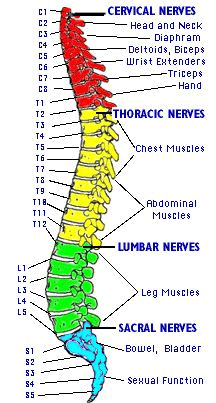 Decompression Sickness (DCS) results from the formation of bubbles in the blood or body tissues, and is caused by inadequate elimination of dissolved gas after a dive or other exposure to high pressure. Decompression Sickness (DCS) results from the formation of bubbles in the blood or body tissues, and is caused by inadequate elimination of dissolved gas after a dive or other exposure to high pressure.
Decompression sickness may also occur with exposure to atmospheric pressure (altitude exposure), as in an altitude chamber or sudden loss of cabin pressure in an aircraft. In certain individuals, decompression sickness may occur from
non-decompression dives, or decompression dives even when decompression procedures are followed meticulously.
Various conditions in the diver or in the diver's surroundings may cause absorption of an excessive amount of inert gas or may inhibit the elimination of the dissolved gas during normal controlled decompression.
DCS can cause any number of complications throughout the body the most
severe being the lodgement of gas
bubbles in the spinal column. The trapped gas bubbles tend
to necratise (choke) the blood supply to the central
nervous system causing paralysis.
Any decompression sickness, although symptoms might be considered
minor by the patient but in actual fact are not (ie joint pain,
numbness & tingling) must be treated immediately by
recompression to prevent a possible worst case scenario
developing.
Arterial
Gas Embolism (AGE)
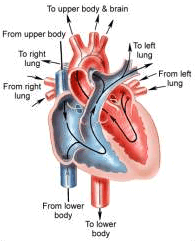 Arterial Gas Embolism (AGE) sometimes simply called gas embolism is caused by entry of gas bubbles into the arterial circulation which then act as blood vessel obstruction called emboli. These emboli are frequently the result of pulmonary barotraumas caused by the expansion of gas taken into the lungs while breathing under pressure and held in the lungs during ascent. The gas might have been retained in the lungs by choice (voluntary breath holding) or by accident (blocked air passages). The gas could have become trapped in an obstructed portion of the lungs that has been damaged from some previous disease or accident; or the diver, reacting with panic to a difficult situation may breath hold without realizing it. Arterial Gas Embolism (AGE) sometimes simply called gas embolism is caused by entry of gas bubbles into the arterial circulation which then act as blood vessel obstruction called emboli. These emboli are frequently the result of pulmonary barotraumas caused by the expansion of gas taken into the lungs while breathing under pressure and held in the lungs during ascent. The gas might have been retained in the lungs by choice (voluntary breath holding) or by accident (blocked air passages). The gas could have become trapped in an obstructed portion of the lungs that has been damaged from some previous disease or accident; or the diver, reacting with panic to a difficult situation may breath hold without realizing it.
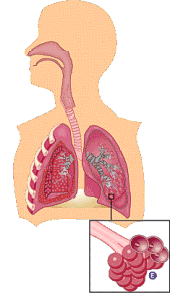 If there is enough gas and if it expands sufficiently, the pressure will force gas through the alveolar walls into surrounding tissues and into the bloodstream. If the gas enters the arterial circulation, it will be dispersed to all organs of the body. The organs that are especially susceptible to arterial gas embolism and that are responsible for the life-threatening symptoms are the central nervous system (CNS) and the brain.
If there is enough gas and if it expands sufficiently, the pressure will force gas through the alveolar walls into surrounding tissues and into the bloodstream. If the gas enters the arterial circulation, it will be dispersed to all organs of the body. The organs that are especially susceptible to arterial gas embolism and that are responsible for the life-threatening symptoms are the central nervous system (CNS) and the brain.
In all cases of arterial gas embolism, associated pneumothorax is possible and should not be overlooked.
AGE may develop within minutes of surfacing, causing severe symptoms that must be diagnosed and treated quickly and correctly because the supply of blood to the central nervous system is almost always involved. Unless treated promptly and properly by recompression, AGE is likely to result in death or permanent brain damage.
Safe
Diving Recomendations
If you observe the following recommendations, the chances of getting decompression sickness
are reduced. This does not guarantee however, that you are 100% RISK-FREE. Most often an aggregate of mild symptoms marks the beginning of the Decompression Syndrome. Never neglect to accept this; do not treat
any sign or symptoms with frivolity. If detected early and treated
the chance of having a speedy and 100% satisfactory recovery are dramatically
increased.
DO: Drink plenty of water (prevent dehydration) and dive conservatively within table/computer limits; ascend slowly- no faster than 30 fpm; limit to three (3) dives within twelve hour period, make safety stops after every dive, plan your dives and make sure that you dive your plan.
DON'T: Over exercise, take hot showers or baths after diving; drink alcohol, coffee and sodas immediately before/or after; avoid getting too cold during and after diving; avoid greasy foods; do not fly immediately after a dive.
Signs,
Symptoms & Emergency First Aid
|
The
Signs |
|
(1) Blotchy skin rash
|
(4) Coughing
Spasms
|
|
(2) Weakness
|
(5) Shortness of
Breath
|
|
(3) Staggering
|
(6) Altered
Mental Status
|
|
|
The
Symptoms |
|
(A) Pain
|
(H) Numbness
|
|
(B) Extreme
Fatigue
|
(I) Dizziness
|
|
(C) Headache
|
(J) Personality
Changes
|
|
(D) Nausea
|
(K) Paralysis
|
|
(E) Itching
|
(L) Reflex
Changes
|
|
(F) Skin Rash
|
(M) Bladder
Problems
|
|
(G) Restlessness
|
-
|
|
|
Emergency
First
Aid |
|
(A) Check airway, breathing, and circulation (ABCs).
|
|
(B) Administer 100% oxygen.
|
|
(C) Place diver in recovery position.
|
|
(D) Treat for shock.
|
|
(E) Transport to the nearest Hyperbaric facility ASAP.
|
|
The Treament of DCI
Introduction
The Diagnosis of Decompression Illness is
not an exact science but an experienced physician using his aquired
knowledge and the information at hand can make a clinical assessment.
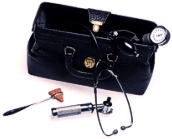 Diagnosis
of DCI Diagnosis
of DCI
Diagnosis of DCI is done by
our SSS Physicians. They use a clinical-neurological assessment of the patient
together with the patients dive history, the patients related
medical history and the signs and symptoms that the patient is
presenting.
Diagnosis
Myths
There are a few myths or
assumptions that non medical divers make. These are that they
believe DCI can be diagnosed by the use of Doppler and through
Blood Testing. This is NOT True.
Please read on.
Blood testing for DCI
During severe DCI, a haemoconcentration "might happen" due to extravasation of plasma through the vessel walls previously damaged by bubbles. The haemoconcentration (relative dehydration) expresses itself by an increase in the haematrocryt which is a correlation between plasma volume and the volume of red blood cells.
The increase of haematocryt is a very unspecific sign common to many pathological conditions. It exists when there is a lack of fluids (dehydration, burns, hemorrhages, etc) and although it might be present in
DCI it does not constitute a certain
diagnosis factor of DCI.
Other biochemical changes can be sometimes be found during DCI but they are at a laboratory level and are never used in the common medical
practice because:
1. They are very expensive,
2. They take TOO long to perform,
2. They are not always present, and
3. None of them can replace a physician's brain when faced with a diver suffering
DCI.
An Ultrasonic Circulating GAS Bubble Detector (USCGBD Doppler)
An ultrasonic circulating gas bubble detector is an expensive piece of equipment. From a
practical viewpoint it is not a common rutinary diagnosis technique for
DCI and it is mainly used with an experimental scope at research labs or similar facilities.
Using an USCGBD is a very skilled procedure that demands special training from the person designed to perform it since it is necessary to "educate the ear" to detecting bubbles. The
physician must learn to discriminate against the sounds that they produce from those which are normally present in the background. ie sounds that are originated by the opening and closure of the heart valves and blood flow reaching and leaving the heart.
It cannot detect stationary or static bubbles lodged for example in the spinal column.
These are Bubbles that have already settled in tissues and are obstructing vessels or that have grown "in situ" within tissues. The only bubbles this apparatus "captures" are those flowing through the heart at the moment of research.
It is not medically possible to establish a diagnosis of DCI by use of a USCGBD
Doppler since the diagnosis of this disease up-to-date is CLINICAL. At the outside, It might only corroborate an already established "clinical
diagnosis or assumption of DCI" done by a clinical-neurological assessment of the patient and only if circulating bubbles are detected.
Conversely, the detection of circulating gas bubbles by the USCGBD
Doppler does not constitute a diagnosis of DCI since 80% of divers
have circulating inert gas bubbles after diving without having decompression
sickness.
Prognosis
A Confident Diagnosis of
DCI
Once a diagnosis of DCI
(either DCS, AGE or maybe both) SSS's Doctors will usually
(PROVIDING THEIR ARE NO OTHER MITIGATING MEDICAL CONCERNS PRESENT) prescribe the following course of action.
1. First Treament: USNTT6 (Implement Table Extensions if required
and modify or use a CATALINA table if Oxygen Toxicity becomes a
problem)
2. Reassess the patient on treatment completion.
3. Second Treatment: USNTT6 (if symptoms are present) USNTT5 (if
the patient is asymptomatic) The USNTT5 is what we call a washout
since most of our diver patients will be flying home within a
week.
4. Reassess the patient on treatment completion.
Repeat the above procedures.
Depending on the severity of the case and the patients condition
(other complications including the ability of the patient to
handle oxygen) the above (general) prescription will be modified on
site by SSS's Doctors.
If SSS's Doctors are Unsure (ie DCI Signs & Symptoms are
present BUT could be attributed to other medical conditions)
They will usually prescribe what we call a Rule Out USNTT6 or
"Trial by Oxygen" (IF) the other mitigating concerns are
considered less threatening to the patients health.
Our doctors always err on the side of caution. If in doubt according
to SSS Recompression Chamber Network protocol we treat. It is in the patients best
interest.
If SSS's Doctors believe it is something other
than DCI
SSS's doctors will not dismiss the patient out of hand. We
will put them on what we call Bend watch.
We will ask them to
either lodge within or close to our facilities and if they develop
sure signs and symptoms then we will be in a position to
immediately recompress them because our staff are on standby to be
called out at any time.
Treatment Tables
The most commonly used tables are the United States Navy Treatment Table 6 (USNTT6) and the United States Navy Treatment Table 5 (USNTT5): there are other tables, which are used for very unusual cases, seldom (if ever) seen in recreational divers.
The Tables dictate the duration of treatment, treatment pressure (ie depth), the gas to be breathed and the descent / ascent rates.
United
States Navy Treatment Table Six (USNTT6)
The USNTT6 is initiated by pressurizing the chamber to 60 fsw or 3 atmospheres, and breathing oxygen for intervals of 20 minutes oxygen and 5 minutes air.
Later the ascent begins on pure oxygen until the next static depth (30 fsw) - another intermittent gas period takes place before the final ascent to surface on oxygen. The length of the USNTT6 is 4 hours 45 minutes. This table can be extended an additional 50 min at 60 fsw and 150 min at 30 fsw if
necessary.
For this table & the USNTT5 the ascent rate will not exceed one foot per minute and descent will take place at 20 feet per minute.
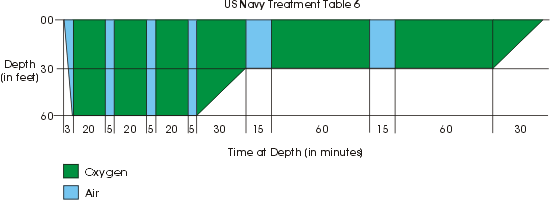
United
States Navy Treatment Table Five (USNTT5)
The USNTT5 is a shorter table, it follows the same trend of pressure, oxygen, oral fluid, and air, but its length is only 2 hours 15 minutes.
It is mainly used as follow up treatment to our USNTT6's to treat any residual symptoms or 'Wash Out' the patients system along with providing oxygen therapy to damaged area's of the body.
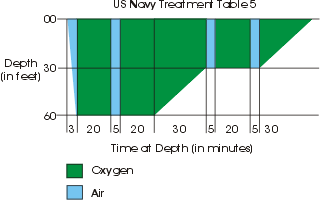
After
Treatment
After every Hyperbaric Treatment, the patient should drink plenty of fluids, avoid hot showers or baths, non-prescribed medications, caffeine, carbonated beverages, alcohol, strenuous exercise, oily spicy foods, avoid exposure to higher elevations (more than 1000 ft) or fly until 72 hours after the last treatment or cleared by the doctor.
Home
| Mission | Marketing
| Standards |
Education | Claims | Billing
Alliances | Affiliates |
Charity | Contact
Us |



